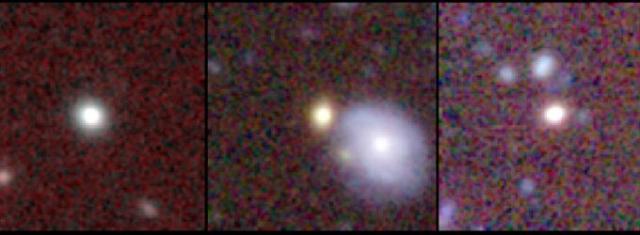Jun 12 2014
The world of astronomy has changed. An astronomer used to have to travel to a remote location and endure long, cold nights, patiently guiding a telescope to collect precious photons of light. Now, a proliferation of online archives allows astronomers to make discoveries from the comfort of their own offices.
 This series of photos shows three "red nugget" galaxies at a distance of about 4 billion light-years, and therefore seen as they were 4 billion years ago. At left, a lonely one without companion galaxies. The one in the middle is alone as well, although it appears to be next to a larger spiral galaxy. That blue spiral is actually much closer to us, only one billion light-years away. Finally, the red nugget on the right might have some companion galaxies residing nearby. Credit: Ivana Damjanov & CFHT MegaCam Team
This series of photos shows three "red nugget" galaxies at a distance of about 4 billion light-years, and therefore seen as they were 4 billion years ago. At left, a lonely one without companion galaxies. The one in the middle is alone as well, although it appears to be next to a larger spiral galaxy. That blue spiral is actually much closer to us, only one billion light-years away. Finally, the red nugget on the right might have some companion galaxies residing nearby. Credit: Ivana Damjanov & CFHT MegaCam Team
By mining such archives, a team of astronomers led by Ivana Damjanov of the Harvard-Smithsonian Center for Astrophysics (CfA) has found a treasure trove of "red nugget" galaxies. These galaxies are compact and densely packed with old, red stars. Their abundance provides new constraints on theoretical models of galaxy formation and evolution.
"These red nugget galaxies were hiding in plain view, masquerading as stars," says Damjanov. She presented the team’s research today at a meeting of the Canadian Astronomical Society (CASCA) in Quebec, QC.
When the universe was young, dense, massive galaxies nicknamed "red nuggets" were common. These galaxies are ten times more massive than the Milky Way, but their stars are packed into a volume a hundred times smaller than our Galaxy.
Mysteriously, astronomers searching the older, nearer universe could not find any of these objects. Their apparent disappearance, if real, signaled a surprising turn in galaxy evolution.
To find nearby examples, Damjanov and her colleagues Margaret Geller, Ho Seong Hwang, and Igor Chilingarian (Smithsonian Astrophysical Observatory) combed through the database of the largest survey of the universe, the Sloan Digital Sky Survey. The red nugget galaxies are so small that they appear like stars in Sloan photographs, due to blurring from Earth’s atmosphere. However, their spectra give away their true nature.
The team identified several hundred red nugget candidates in the Sloan data. Then they searched a variety of online telescope archives in order to confirm their findings. In particular, high-quality images from the Canada-France-Hawaii Telescope and the Hubble Space Telescope showed that about 200 of the candidates were galaxies very similar to their red-nugget cousins in the distant, young universe.
"Now we know that many of these amazingly small, dense, but massive galaxies survive. They are a fascinating test of our understanding of the way galaxies form and evolve," explains Geller.
The large number of red nuggets discovered in Sloan told the team how abundant those galaxies were in the middle-aged universe. That number then can be compared to computer models of galaxy formation. Different models for the way galaxies grow predict very different abundances.
The picture that matches the observations is one where red nuggets begin their lives as very small objects in the young universe. During the next ten billion years some of them collide and merge with other, smaller and less massive galaxies. Some red nuggets manage to avoid collisions and remain compact as they age. The result is a variety of elliptical galaxies with different sizes and masses, some very compact and some more extended.
"Many processes work together to shape the rich landscape of galaxies we see in the nearby universe," says Damjanov.
Headquartered in Cambridge, Mass., the Harvard-Smithsonian Center for Astrophysics (CfA) is a joint collaboration between the Smithsonian Astrophysical Observatory and the Harvard College Observatory. CfA scientists, organized into six research divisions, study the origin, evolution and ultimate fate of the universe.
For more information, contact:
David A. Aguilar
Director of Public Affairs
Harvard-Smithsonian Center for Astrophysics
617-495-7462
[email protected]
Christine Pulliam
Public Affairs Specialist
Harvard-Smithsonian Center for Astrophysics
617-495-7463
[email protected]
Leslie Sage
Canadian Astronomical Society
301-675-8957
[email protected]